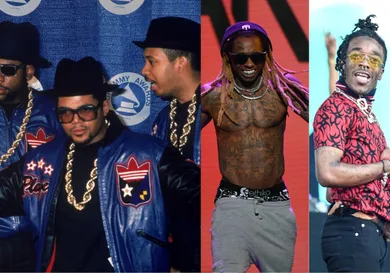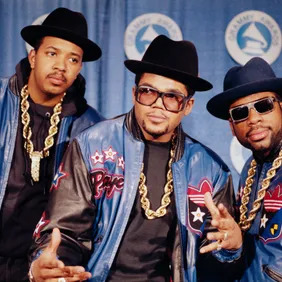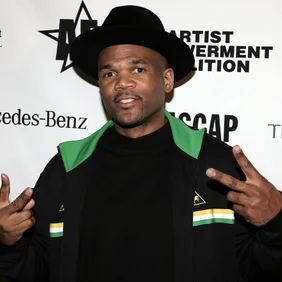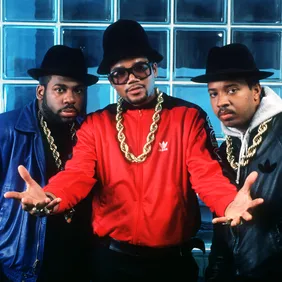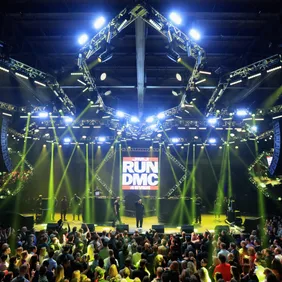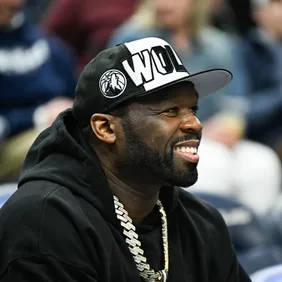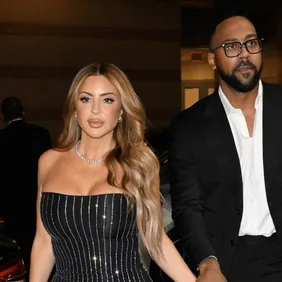When most people hear the term ‘rock music,’ they think of artists like Guns N’ Roses, Pink Floyd, and Iron Maiden. But rock is a genre that evolved from the blues, and was invented by the Black musicians Chuck Berry, Bo Diddley, and Little Richard (the original ‘Lil’?). Throughout hip hop history, from Run-D.M.C and Ice-T, to Kid Cudi and Lil Uzi Vert, rappers have reclaimed rock as a genre created by Black artists by incorporating rock into their music and fashion.
The past few years have seen a surge in ‘rockstar’ rappers like Lil Uzi Vert, Travis Scott, and Playboi Carti. These artists sample rock music, use guitar-like distortion on their vocals and 808s, wear rock-inspired clothing, and stage dive at their mosh-heavy concerts. But they are far from the first artists to mix hip hop and rock. Rock has been a part of hip hop since the genre’s beginning, when DJ’s like Afrika Bambaataa would spin The Beatles, Rolling Stones and other rock classics along to funk breaks in their DJ sets. At the time though, radio stations and MTV were still very intent on keeping white-dominated rock music separate from hip hop. One of the first artists to uproot that segregation was Run-D.M.C.
After releasing their first single "It's Like That/Sucker MCs" in 1983, New York trio Run-D.M.C. teamed up with guitarist Eddie Martinez to create some of the first rap-rock songs, including 1984’s “Rock Box” and 1985’s “King of Rock.” The music video for “King of Rock” depicted Run-D.M.C. being stopped at the door to the Rock and Roll Hall of Fame by an old white security guard. The security guard yells, “This is a Rock and Roll museum! You guys don’t belong in here,” to which D.M.C. replies, “I’m the King of Rock, there is none higher! Sucka MC’s should call me sire!” By calling himself the King of Rock, D.M.C. reminded the white security guard that the Rock and Roll Hall of Fame is indebted to the Black originators of rock music, and that hip hop is the future advancement of rock. In 1986, Run–D.M.C. teamed up with Def Jam producers Russell Simmons and Rick Rubin for an unlikely collaboration with Aerosmith. The product, “Walk This Way,” became the first rap single to land on the Billboard Top 10 charts, and the first hip hop music video to appear on MTV, introducing many rock listeners to hip hop for the first time. The music video showed Run-D.M.C smashing through a wall standing between them and Aerosmith, literally knocking down the barrier between hip hop and rock. In 2009, Run-D.M.C. was awarded their rightful place in the Rock and Roll Hall of Fame.
After Run-D.M.C., Def Jam became the home for many early rap-rock crossovers, including LL Cool J’s 1986 AC-DC-sampling “Rock the Bells,” and the Beastie Boys’ 1986 debut album Licensed to Ill. Originally formed as a hardcore punk band, the Beastie Boys brought the attitude and energy of rock to hip hop production. Licensed to Ill sampled the Roland TR-808 drum machine, classic funk bands like Kool & The Gang, and other rap groups at the time like Run-D.M.C. But the Beasties also recruited Slayer guitarist Kerry King to play on the track “No Sleep ‘Till Brooklyn,” creating a combination of rock and hip hop entirely new to many listeners. “No Sleep 'Till Brooklyn" proved to be highly influential, and was covered by Jay-Z at the All Points West Festival in 2009.
In 1987, another Def Jam group named Public Enemy released “Bring the Noise” for their classic album It Takes a Nation of Millions to Hold Us Back. With the lines, “Roll with the rockstars but never get accepted as,” Public Enemy pointed out the discrimination they face as hip hop artists who don’t receive the same recognition from critics that rock artists do. Like Run-D.M.C. did on “King of Rock,” Public Enemy rapped about the irony of being excluded from rock platforms, as rock was invented by Black musicians. “Soul control, beat is the father of your rock'n'roll,” Chuck D rapped. “Bring the Noise” also shouted out the thrash metal band Anthrax, who wore Public Enemy shirts at their gigs. In 1991, “Bring the Noise,” was given a heavy metal remix, with Anthrax’s breakneck guitar riffs and pounding drums backing up Chuck D and Flavor Flav’s in-your-face bars.
On March 3rd 1991, American taxi driver Rodney King was pulled over for speeding by the LAPD and brutally beaten in a violent arrest. The whole event was caught on camera, yet the malicious police officers were ruled not guilty by a predominantly white jury. The injustice faced by Rodney King, as part of the widespread pandemic of police brutality in the U.S., as well as the murder of fifteen-year-old Latasha Harlins, whose assailant faced similarly meager legal consequences, sparked the 1992 Los Angeles riots. Lasting for a full week, the L.A. riots forced the president to send in the army and marines, resulting in 63 people killed, over two thousand injured, and over twelve thousand arrested.
In March 1992, rapper Ice-T released the self-titled debut album for his rap-metal band Body Count, featuring the revolutionary single “Cop Killer.” The song’s lyrics, yelled out between rapid-fire guitar riffs and pummelling drums, paid tribute to Rodney King: “FUCK THE POLICE, for Rodney King.” The song's incredible hook went, “I'm a cop killer, better you than me / Cop killer, F*CK POLICE BRUTALITY.” The message of “Cop Killer” was powerful, but white conservatives distorted it by framing the song as malicious and uncalled for. Instead of “Cop Killer” sparking a conversation about police brutality, as Ice-T had intended it to, it incited an unnecessary debate over the limits of free speech. The song was condemned by President George H. W. Bush, Vice President Dan Quayle, and the Parents Music Resource Center, forcing Ice-T to take it off his album. But “Cop Killer” remains today one of the greatest rap-rock protest songs of all time.
In addition to “Cop Killer,” the L.A. Riots inspired a number of protest songs, including the classic “Killing in the Name” by Los Angeles rap-rock band Rage Against the Machine. “Killing in the Name” compared the police force to the KKK, repeating the lines, “Some of those that work forces, are the same that burn crosses.” The song refuses to accept “killing in the name of” anything, including the supposedly-righteous law. Rage Against the Machine addresses the police force directly, rapping “You justify those that died / By wearing the badge / They're the chosen whites.” Born to a Mexican-American father, with a grandfather who fought in the Mexican Revolution, Rage’s frontman Zach de la Rocha was raised with a passion for political change. Backed by bassist Tim Commerford, guitarist Tom Morello, and drummer Brad Wilk, De la Rocha rapped to live rock instrumentation, creating a dynamic sound called ‘nu-metal’ that influenced many future rap-rock groups.
One of the most famous bands to carry on the sound of nu-metal was the California group Linkin Park. Emerging at the time of the rise of emo rock, Linkin Park adapted the urgent sounds of groups like Run-D.M.C., Public Enemy and Rage Against the Machine, but focused their lyrics on more personal rather than political issues. Singer Chester Bennington and rapper Mike Shinoda spoke on themes of depression, isolation, and drug abuse. Their 2000 debut album Hybrid Theory was conceived of as a ‘hybrid’ between rock and hip hop, combining electronic samples with live rock instrumentation. On the DVD The Making of Minutes to Midnight, Mike Shinoda said that the band was heavily inspired by the sound of sampling, and attempted to play their instruments in rhythmic loops that resembled sampling machines. In 2004, Linkin Park released Collision Course, a collaborative EP with Jay-Z. The single "Numb/Encore," a mash-up of "Numb" by Linkin Park and "Encore" by Jay-Z, also featured backup vocals by Kanye West.
The emotional vulnerability of bands like Linkin Park, as well as the death of his own mother, inspired Kanye West to create 2008’s 808s & Heartbreak. 808s sounded nothing like Kanye’s previous work, and nothing like other hip hop around at the time. It was sparse, cold, and melodic, consisting of somber autotune singing over minimalist beats. Much of the creative directions of 808s were credited to the contributions of Kanye’s G.O.O.D. Music label-mate Kid Cudi, who released his debut album Man on the Moon in 2009. Pushing the ideas of 808s & Heartbreak even further, Man on the Moon openly discussed depression, loneliness and suicide to a degree of vulnerability that was rare in hip hop at the time. The album’s dark single “Day ‘N’ Night” contained lines like, “The pain is deep / A silent sleeper / You won't hear a peep.” Man on the Moon pushed sonic boundaries as well, featuring collaborations with indie electronic bands Ratatat and MGMT, who contributed soaring guitars and synths to the anthemic single “Pursuit of Happiness.”
Cudi blended genres even further on his 2010 album Man on the Moon II, for which he collaborated with indie rock acts St. Vincent and HAIM. “One thing I wanted to do was combine sounds that really bring out intense moods,” Cudi said in a 2009 interview with HipHopDX. Yet, Kid Cudi remained heavily inspired by hip hop. In the same interview, he went on to cite Public Enemy as one of his biggest influences. “Just because it had a bad-ass nature doesn’t mean that they weren’t expressing their emotions. And that’s all I’m doing in my music.”
Also in 2010, Lil Wayne released Rebirth, a rap-rock album that featured Wayne autotune singing over pop-punk guitars. Critics largely dismissed the album, calling it "a total misperception of what makes a rock record." But that quote itself shows how critics attempted to box Wayne into certain categories, failing to see him as a unique artist in his own lane. Wayne’s Rebirth, as well as Kid Cudi’s later rock-focused albums WZRD and Speeding Bullet to Heaven, were glaring examples of the music media immediately shutting down Black artists for stepping outside of the confines of what is deemed as ‘Black music.’ A quick scroll through the YouTube comments on Lil Wayne’s “Prom Queen” music video, and you see multiple people in 2018 remarking upon how the 2009 song must have inspired Lil Uzi Vert. The way Wayne used autotune on Rebirth, and the raw rock attitude of the album, proved to be highly influential on the next generation of rap rockstars.
In 2012 Kanye and Kid Cudi’s G.O.O.D. Music label signed Houston prodigy Travis Scott, originally as part of the label’s production wing, and later as a rapper himself. Growing up listening to artists like Kanye, Kid Cudi and Lil Wayne, as well as Björk, Little Dragon and Portishead, Travis incorporates a diverse range of influences into his unique sound. Travis saturates his autotuned vocals with distortion, overdrive and reverb, replicating the sound of a guitar with his voice. This technique was pioneered by Kanye West on the song “Runaway.” What many people at first thought was a guitar solo on “Runaway” was actually a manipulation of Kanye’s voice. Like Kanye on 808's and Kid Cudi, Travis’ delivery is highly melodic, bordering on singing. Cudi featured Travis on his 2016 song “Baptized in Fire,” and Travis featured Cudi on “Through the Late Night,” which samples Cudi’s classic “Day ‘N’ Night.” Travis Scott’s new album Astroworld features a psychedelic collaboration with rock band Tame Impala on “Skeletons” and samples the Beastie Boys on the track “Carousel.”
It’s 2018, and rap-rock shows no signs of stopping or slowing down. The emotionally vulnerable lyrics of artists like Linkin Park, Kid Cudi and Kanye West have inspired a whole generation of ‘emo rappers’ including Juice WRLD, Lil Peep, and Lil Uzi Vert. Citing Pharrell Williams and Paramore as two of his biggest inspirations, Lil Uzi Vert’s breakout 2017 single “XO Tour Lif3” stole the hearts of millions with its irresistible tear-drenched hook, “I DON’T REALLY CARE IF YOU CRYYYY / ON THE REAL YOU SHOULDA NEVER LIEEEED.” Veterans of the genre are still at it too, including Rage Against the Machine, Public Enemy and Cypress Hill, who came together in 2016 to form the political supergroup Prophets of Rage. And while rap-rock has historically tended to be male-dominated, badass women like Princess Nokia, Rico Nasty and Bali Baby have been asserting their place in recent years as certified rap-rockstars. Rap-rock is a genre born out of reclamation and political protest. The artists of today are redefining preconceptions of what a rockstar has to look and sound like. As Princess Nokia wrote on her Instagram, “I LOVE to see my brown body take space in rock music and make you feel uncomfortable.🖕🏾” Rock on.
This article is the third part in a three-part series of "Brief Histories." If you liked this article, you can check out our Brief History of G-Funk right here.
And our Brief History of Jazz-Rap here.
